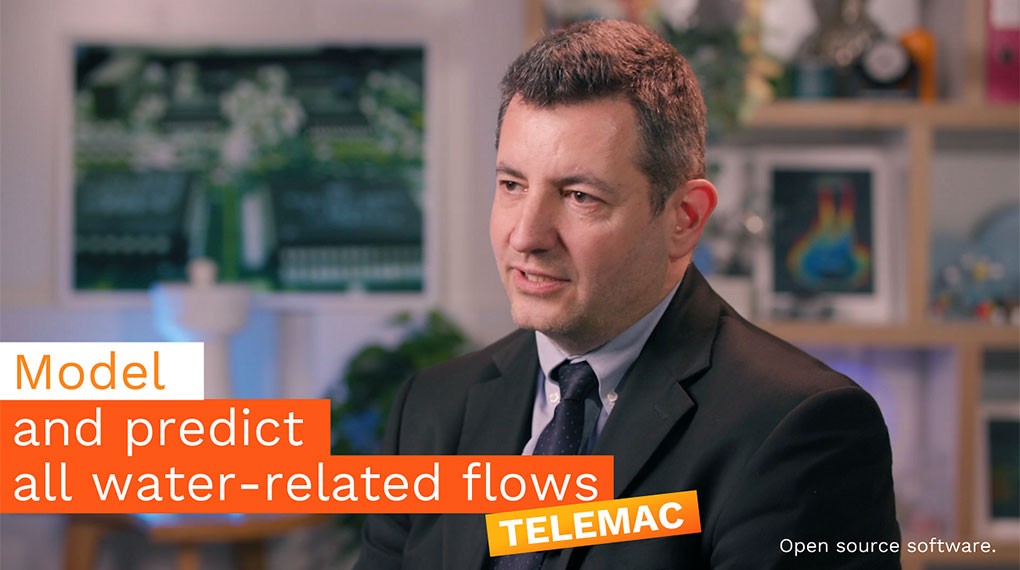Developed for more than 35 years by EDF R&D in collaboration with other French, European and international organisations, the TELEMAC system is a set of scientific computation solvers, coupled and parallelized, dedicated to the modelling of free surface environmental hydraulics.


Your browser does not support javascript.
To enable you to access the information, we suggest you view the video in a new tab.
The TELEMAC environment
The TELEMAC system is composed of the following components, each of which relates to a specific physics, and all of which are coupled together to solve complex problems:

TELEMAC-2D : modelling of the free-surface shallow water equations in 2D, or the so-called Saint-Venant Equations, in addition to which others such as the Boussinesq Equations, several turbulence models, modelling of tidal and gravitational forces, interaction with winds and other atmospheric quantities or even advection-diffusion of tracers.

TELEMAC-3D : modelling hydrodynamics in 3D through the so-called free-surface non-hydrostatic Navier-Stokes equations, in addition to which several 3D turbulence models, stratification models or advection-diffusion of active (driving density) or passive tracers.

MASCARET : modelling of free-surface shallow water equations in 1D, or the Saint-Venant equations, with non-hydrostatic reconstruction, formulated on the basis of finite elements and finite volumes. A model with interconnected compartments makes it possible to take into account inundation zones, relatively isolated from the major riverbed.

GAIA : modelling 2D and 3D sediment transport in suspension and through bedload using the Exner or advection-diffusion multi-class equations, cohesive and non-cohesive, in addition to a panoply of formulas and empirical models representing the physics of phenomena such as erosion, deposition, flocculation, fall velocity or compression of freshly deposited sediment layers.

TOMAWAC : spectral modelling of swell and wave transformation from the open sea to coastal areas, known as a 3rd generation model, completed with a range of formulations representing the physics of phenomena, among others refraction, diffraction, surging, reflection, white capping, wave breaking, etc.

ARTEMIS : modelling of the free surface due to agitation in the coastal zone, inside ports or near infrastructures, based on elliptical equations known as mild-slope equations, and making it possible to predict the reflection of waves by an obstacle, the diffraction of waves behind an obstacle, the refraction of waves by seabed variations, regular waves, monodirectional or multidirectional random waves, bathymetric breaking, etc.

KHIONE : modelling of suspended frazil formation and ice cover, based on an advanced heat balance, and taking into account interactions between water, air and frazil concentration, freezing processes and static and dynamic ice cover formation, as well as the effects of undercover ice floes or on structures such as clogging on racks.

WAQTEL : modelling of biochemical and thermal processes within water bodies in the natural environment. This component includes a complete model of heat exchange with the atmosphere. It includes processes related to the oxygen, algae, ammonia and phosphate cycles, as well as biomass and radionuclide processes in suspension or dissolved. A coupling to the AED2 library is also available for more advanced water quality simulations.
Finally, the COURLIS and TRACER components can also be mentioned as the 1D equivalents of the GAIA and WAQTEL components mentioned above.
The mathematics of the TELEMAC system is a strength:
Since its inception, the TELEMAC system has been essentially based on the finite element method, which its strength is to be deployed for unstructured meshes.

Mathematical discretization: Distributive schemes are available, close to finite volume formulation, which are also implemented in some components of the TELEMAC system. Triangle-based prism meshes define the 3D layers, which can vary according to classical transformations such as sigma or sigma-generalized, but also according to redistributions tracing the stratified zones.

Physical laws: Several turbulence models can be selected in 2D or 3D. These include constant viscosity, mixing length, Smagorinsky, k-epsilon, k-omega, Spalart-Allamaras and Detached Eddy Simulation models.
Similarly, several bottom friction laws can be selected, such as Haaland's, Chezy's, Strickler's, Manning's or Nikuradse's law in 3D.
Download links
Community website: ici
Downloading through Git : ici
Referred images :
- TELEMAC-2D : ici
- TELEMAC-3D : EDF R&D, Test case « goutedo »
- MASCARET : EDF R&D, Malpasset Dam
- ARTEMIS : ici
- KHIONE : ici
- WAQTEL : EDF R&D, Test case « reservoir »
- Discretization : EDF R&D, Avant-port de Dunkerque Ouest
- Physical laws : EDF R&D
TELEMAC is available on MS-Windows and GNU/Linux operating systems, and is distributed as free software under the GNU GPL v3 licensing.
